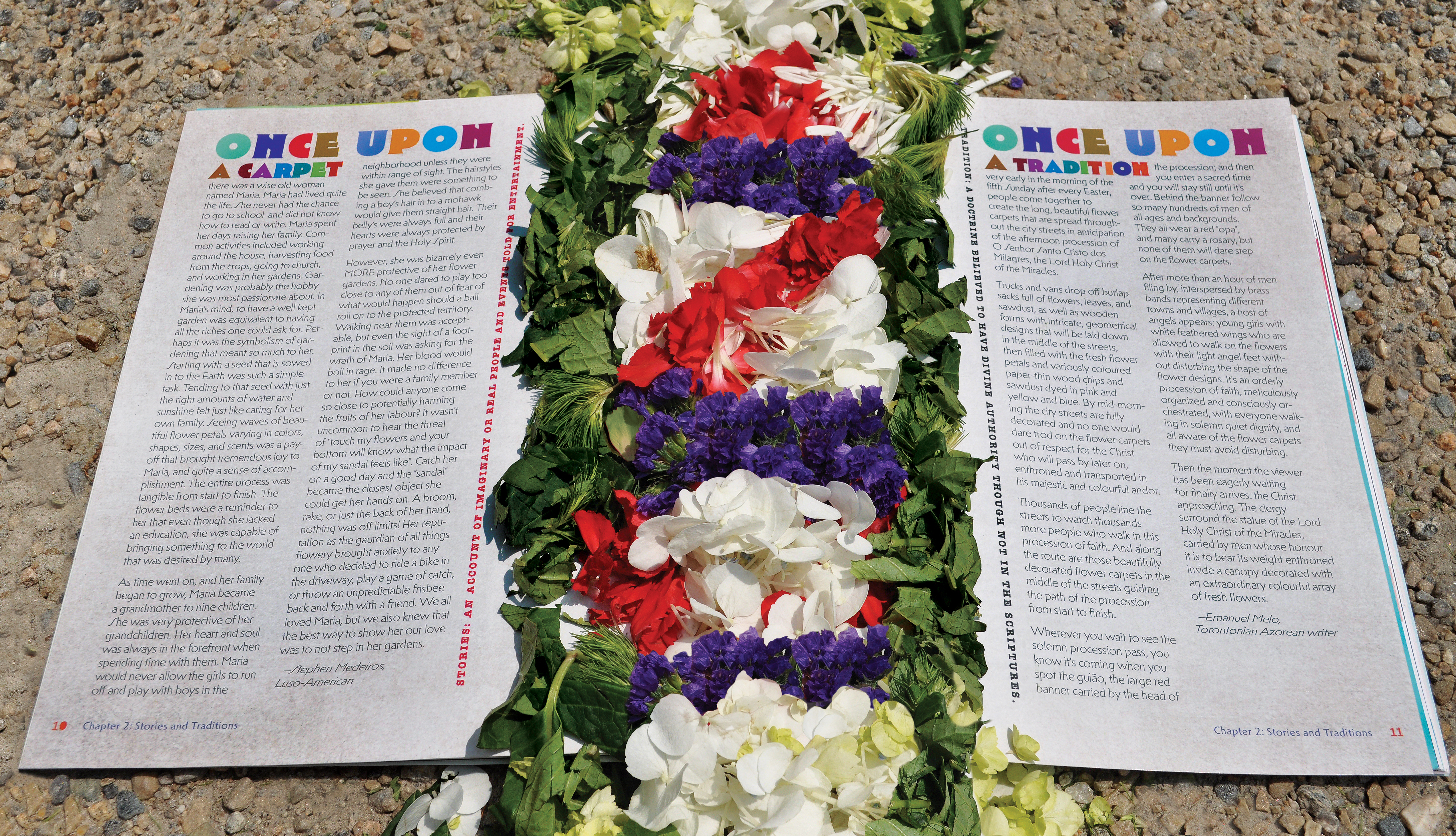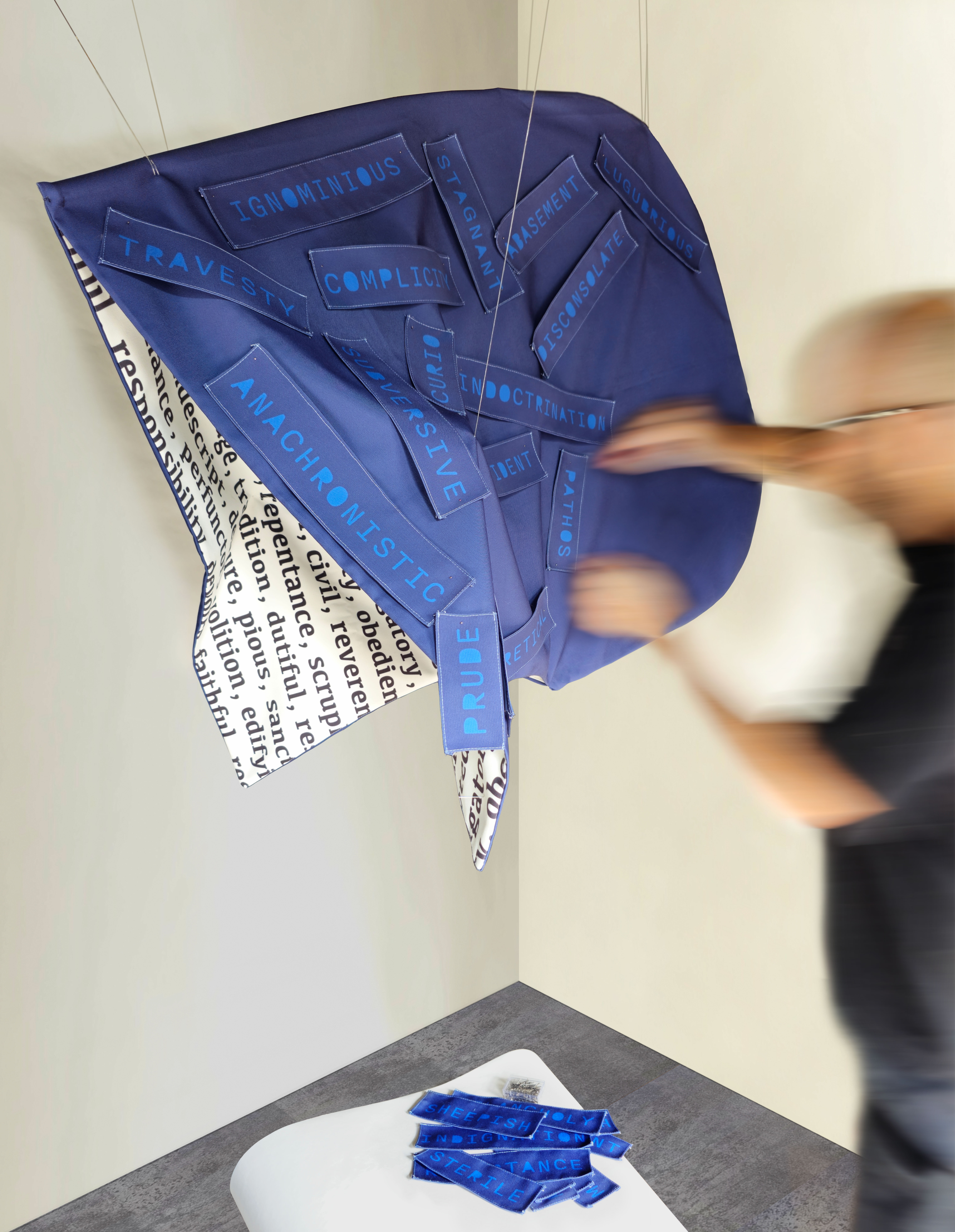SITE SPECIFIC
These site specific works are my investigations in to traditions that are very important and prevalent to this day in the Portuguese community. The following works are my responses to cultural and religious traditions I have either experienced first-hand, or been told about through storytelling from my parents and grandparents.

ROMEIROS, Scaffolding, textiles, paper, rosary beads, 5' x 7'
Romeiros, a graphic pattern that weaves this tradition into a place of shelter and protection. A vulnerable, spiritual, and powerful experience for anyone who has participated or witnessed this tradition in person. The Romeiros are a group of men who march for 8 days and 7 nights, roaming from church to church. They pray the rosary to the Virgin Mary as they march while only stopping for bio breaks and sleep. Originally they marched and prayed to stop the natural disasters that were plaguing their island. Today, they continue the tradition here in the United States as a sign of faith, devotion to their religion, and to pay homage to their past. There are 8 strips of striped fabric (one for each day they march) which are overlapped, or interrupted, 7 different times (one for each night they spend looking for shelter and a place to rest their head). All the fabrics represented are examples of fabrics the men would be wearing as their scarf or shawl. The pattern intertwines itself with an image of the Virgin Mary representing the complexities of how their faith is a part of the fabric of their sacrifice. 100 rosaries hang above the weary figure as a reminder of the work that lies ahead, but also as a sign of protection while he sleeps. For overnight accommodations they rely on the kindness of strangers to open their homes to these strangers. If that does not work, the closest church will often let them sleep on the floor.

Once Upon A Carpet/Once Upon a Tradition, Site Specific layout/Flower petal carpet, 18.5" x 11"
Two stories side by side. The story on the left, written by me, provides a clear picture my grandmother’s intense love for gardening. It investigates the overbearing protectiveness she had for her gardens as a response to her lack of education. What she lacked in schooling she made up for in the garden. In her mind, the fruits of her labor were a direct connection to her faith. The greener her thumb became the more intense her faith grew in religious spirit and traditions. She often gathered her flowers and donated them to the church to help create flower carpets for the Feast of Santo Cristo dos Milagres. A religious and cultural tradition where a statue of Jesus is carried over a carpet of flower petals around town. Details of that tradition can be found in the article on the right page of this piece written by Emanuel Melo. This is the same tradition that inspired my digital Typography piece, Thoughts and Prayers.

CAPELO, Interactive graphic sculpture, 40" x 30"The “Capote e Capelo” is a characteristic garment of Azorean clothing and was, for a long time, the traditional costume for women. The “Capote” was basically a round cape that reached to the feet; the “Capelo” was the broad head covering. It was an inherited garment, passing on from generation to generation, and sometimes serving the whole family (women only). Mandatory pieces of the bride’s dowry, it also served as an engagement attire. Therefore, for the poorest women, the great ambition was to own a Capote e Capelo. It was used by women throughout the archipelago, until the middle of the 20th century. After years of discussing this fashion with my family who remember their own grandmothers wearing them, I found that the women of that time looked at this garment to be somewhat of a status symbol in their village. CAPELO presents the viewer with a larger than life interpretation of one of these hoods. The inside is lined with words that express thoughts women of that time felt while going about their day around town in one of these outfits. The sculpture invites the viewer to interact with the hood by pinning word patches to the outside that express how the hood makes them feel. In a world where we still continue to fight for equality and women’s rights, CAPELO is sure to stir up intense feelings. It is an open invitation for direct dialogue with the artist.

History of A Love Letter, Site specific printed scroll, 24" x 156"
My whole life I have heard about the story of how my parents got to know each other in the Azores. For 7 years through a window, Romeo and Juliet style, the courtship began and developed. My mother in her bedroom window with my grandmother seated in the room as a chaperone, and my father at street level on his motorcycle. Hand written notes and waiting for responses came soon after. These stories feel like fairytales in our world today. Who hand writes a letter anymore? Who even picks up a phone to call someone? The way technology today influences communication is advancing at such a rapid pace that the sparks in our romantic endeavours are being directly affected and diminished.